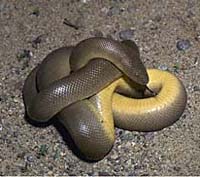Superregnum: Eukaryota
Regnum: Animalia
Subregnum: Eumetazoa
Cladus: Bilateria
Cladus: Nephrozoa
Superphylum: Deuterostomia
Phylum: Chordata
Cladus: Craniata
Subphylum: Vertebrata
Infraphylum: Gnathostomata
Superclassis: Tetrapoda
Cladus: Reptiliomorpha
Cladus: Amniota
Classis: Reptilia
Cladus: Eureptilia
Cladus: Romeriida
Subclassis: Diapsida
Cladus: Sauria
Infraclassis: Lepidosauromorpha
Superordo: Lepidosauria
Ordo: Squamata
Subordo: Serpentes
Superfamilia: Booidea
Familia: Boidae
Subfamilia: Charininae
Genus: Charina
Species (2): C. bottae – C. umbratica
Name
Charina Gray, 1849
References
Links
Uetz, P. & Hallermann, J. 2021. Charina . The Reptile Database. Accessed on 2 May 2021.
Charina is a genus of nonvenomous boas found in North America. Three species are currently recognized.[2]
Common names: rosy boas, rubber boas.[2]
Distribution and habitat
Found in North America from southwestern Canada south through the western United States into northwestern Mexico.[1]
| Species[2] | Taxon author[2] | Subsp.*[2] | Common name[2] | Geographic range |
|---|---|---|---|---|
C. bottaeT

|
| (Blainville, 1835) | 0 | Rubber boa | Southwestern Canada in southeastern British Columbia. The northwestern and western United States in most of Washington, Oregon, Idaho, western Montana and Wyoming, northern and central Utah, and as far south as northern Nevada and Monterey County, California.[1][3] | |
| C. umbratica | Klauber, 1943 | 0 | Southern rubber boa | The United States in southern California (Riverside and San Bernardino counties).[3] |
C. trivirgata

|
| Cope, 1861 | 5 | Rosy boa | Southwestern United States. Baja California. Arizona and Sonora in Mexico |
*) Not including the nominate subspecies.
T) Type species.[1]
Taxonomy
Sources vary on how many species the genus contains. Some consider the rubber boa, C. bottae, to be the sole member of the genus. In addition, some experts consider the southern rubber boa, C. umbratica to be a subspecies of C. bottae. Although the Calabar python, Calabaria reinhardtii has been included in Charina, recent phylogenetic analyses based on DNA have shown that it does not belong to this genus.[4]
References
McDiarmid RW, Campbell JA, Touré T (1999). Snake Species of the World: A Taxonomic and Geographic Reference, Volume 1. Washington, District of Columbia: Herpetologists' League. 511 pp. ISBN 1-893777-00-6 (series). ISBN 1-893777-01-4 (volume).
"Charina". Integrated Taxonomic Information System. Retrieved 25 November 2015.
Wright AH, Wright AA (1957). Handbook of Snakes of the United States and Canada. 2 volumes. Comstock Publishing Associates, a division of Cornell University Press. (7th printing, 1985). 1,105 pp. ISBN 0-8014-0463-0. (Genus Charina, p. 53).
Pyron, R. Alexander; Burbrink, Frank T.; Wiens, John J. (2013). "A phylogeny and revised classification of Squamata, including 4161 species of lizards and snakes". BMC Evolutionary Biology 13: 93.
Further reading
Gray JE (1849). Catalogue of the Specimens of Snakes in the Collection of the British Museum. London: Trustees of the British Museum. (Edward Newman, printer). xv + 125 pp. (Charina, p. 113).
Kluge AG (1993). "Calabaria and the phylogeny of erycine snakes". Zoological Journal of the Linnean Society 107: 293–351. PDF at University of Michigan Library. Accessed 20 July 2008.
Retrieved from "http://en.wikipedia.org/"
All text is available under the terms of the GNU Free Documentation License

